The traveler in me craves adventure, the wanderer yearns for time to get lost and the educator in me longs for stimulating informal learning. Travel merges all of these ‘itches’ and as long as every once an awhile I get to run my toes through the sand, I’m quite satisfied. I think I’ve always been an educator. Camp counselor, swim instructor, and advisor are just a few of the jobs I’ve had in life. It’s not very surprising that I became a teacher, but to many it’s shocking that I left the profession after more than fifteen years in the classroom. Often school’s informal lessons and those learned outside the classroom stay with us far longer than a recitation of formulas and dates. Ethics, cultures, values, kindness and human characteristics are not quantifiable, yet for me they hold far more quality than any exam score. When the world is your classroom, you become a global student and more importantly, a global citizen. Travel breeds cultural development and internationally minded people defying stereotypes one passport stamp at a time.
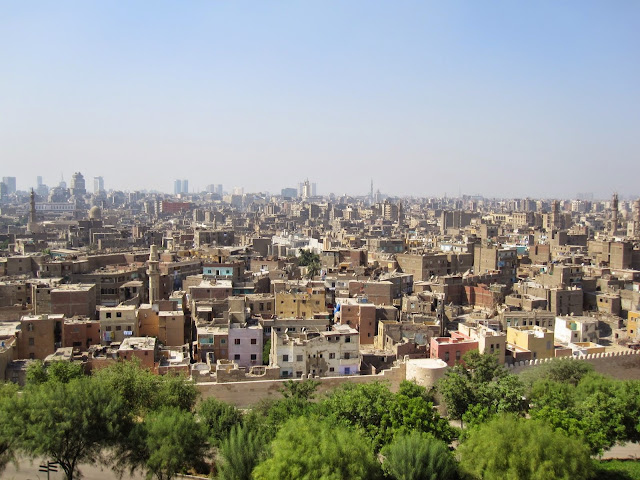
Cairo skyline
Cairo breathes learning. The first step off the plane is different. That first glimpse of the Nile and blaring toot of a taxi’s horn and you know you’re in Cairo. Heat, dust, and smoke from the thousands of hookah pipes fill the air and your lungs as you take your first breath. Here ‘look both ways before you cross the street’ has a completely different meaning. In Cairo, you are surrounded by old and new worlds colliding at every turn. Spices of all colors and fragrances waft into your senses in markets, restaurants, and stalls. History leaps off the street in papyrus, religion, and all things pyramid. Egypt tells a story through the eyes of its people, the flow of its river, and the architecture of its history.
On our way to the hotel we had to cross a bridge. Hugging the side of the street I was already on, I looked below the railing and there it was. I was standing above the Nile. The longest river in the world, whose characteristics get at least a full forty minutes in a New York Global History class, was at my fingertips. This was surreal. And then we had to cross the street. Major roads in Cairo have no street lines, stop signs, or stoplights. Traffic moves at one pace: fast! The rule of thumb is to walk with purpose, keep your wits about you, and once you’ve started…KEEP GOING! You may not take a single breath the entire time, but you’ll be sure to make it safely across to the other side.
History abounds in Cairo. Throughout the day, the sound of the muezzin calling worshippers to prayer echoes through the streets. Dust is omnipresent. Amidst travelers and locals in both western and traditional dress, life happens. Markets bustle, religion is practiced, air-conditioning pumps away, and bottled water is key! In October of 2009, Mathew and I spent ten days in Egypt on a gAdventures tour. We visited Cairo, Giza, Aswan, and Luxor. Egyptian culture smacked us in the face daily, and we learned every step of the way. Our guide, Mayer, had a degree in Egyptology and tourism. He was a font of knowledge on all things Egyptian and took immense pride in sharing his country with visitors.
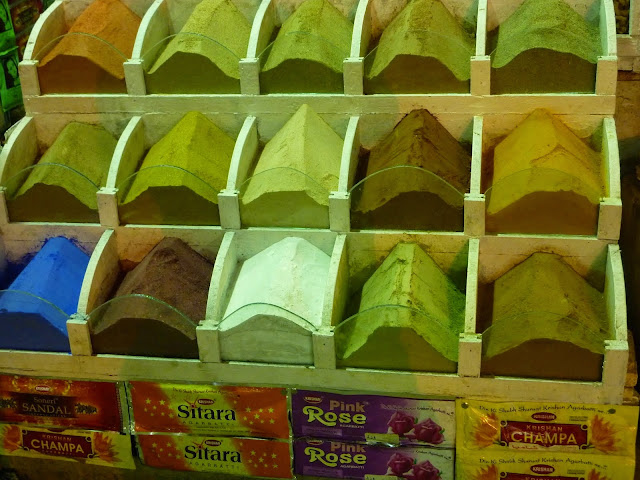
Spice market
Amidst the hills, architecture, religion, and archeological treasures, people make up the wealth of Cairo’s culture. Spending time in the Egyptian Museum wandering from room to room filled with life size artifacts, including an original piece of the Rosetta Stone and actual jewels worn by King Tut himself, we absorbed this living history. We learned about observance and artifacts through first hand experience. We took off our shoes and I covered my shoulders upon entering mosques. We learned that the ages of the various mosques could be seen in their different shapes (tall pencil type architecture vs onion domed). Our first afternoon, we were privileged to a vegetarian lunch called kushari. It was made of fried onions, lentils, chick peas, & macaroni noodles and you mix in tomato sauce into the entire dish to add extra flavor if you choose. Religious dress varies from those in western clothing to those covered from head to toe in traditional garb. While for some, prayer happens daily, for others the focus of life is making a living or going to school. Wares and trinkets are readily available to bring home, but Egypt has very specific exports all its own.
Papyrus, perfumes, hookah pipes, and cartouches are the main gifts found to be purchased by travelers. Papyrus is the first type of paper in the world and comes directly from the papyrus plant. Like the lotus flower, papyrus plants grow exclusively in Egypt. Often in tourist shops, the ‘papyrus’ is actually banana leaf paper, which is much less expensive to make. The government handles the papyrus plants and if you’re interested in a tactile demonstration, head to a papyrus institute to see exactly how plants become paper...talk about an educational experience! You watch first hand how a piece of a tree/branch is soaked, stripped, and pressed into a paper durable enough to withstand the Egyptian climate - and delicate enough to create beautiful artwork. Although we didn’t buy a large-scale tapestry, I did pick up a smaller gift to use in my classroom. My piece of papyrus was an artifact that worked in two different ways. First, it was on true papyrus, and second, it was the alphabet written in Egyptian hieroglyphics. My students would be able to see exactly how their name would be written in a language completely different than their own. The cartouche, another of the popular Egyptian exports, is a hieroglyphics nameplate and is one of the most purchased gifts on an Egyptian holiday. Again, it acts as a reminder of a time gone by and a special gift from a foreign land.

heiroglyphs
From Cairo we ventured to Giza, home to one of the world’s most iconic treasures, the Great Pyramids. They are as majestic as one dreams they might be. There they stand, immense and filled with wonder; the awe we felt inexplicable. Some of the pyramids have weathered over time, but when we look out across the sand and these triangular spectacles of architecture stare back, we’re immediately transported to a movie set and smile ear-to-ear, knowing that this is a magical moment. After reading so many books and seeing their images pop up on Google, it’s an amazing feeling to stand in their presence. This is the reason so many came on this trip-this day, this minute, right now. Pyramids, camels, desert, and the Sphinx in one afternoon…no textbook can ever compete with this feeling!
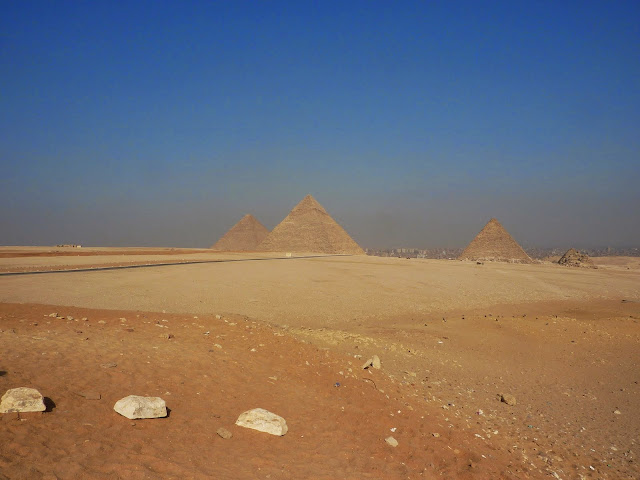
Pyramids of Giza
Hard to contend with the amazement of the pyramids, but more architectural feats await in Egypt. Abu Simbel, situated on the banks of beautiful water, are two temples carved into the mountainside created by Ramses II. These are immense sculptures carved inside and out of mountains and further intricate designs upon entering their gates await. Talk about math and science skills up close and personal. Ramses created the temple so that the sunlight would enter inside and shine directly on a statue of him on his birthday and another sacred day. Considering that half of us today can’t get around our own neighborhood without Google maps, this is something to talk about! There’s even a second temple created for his goddess wife. Not only did we find it incredible that these marvels exist, but, they were moved due to sandstorms and floods and only one statue was partially destroyed by a fluke earthquake. When the temples were moved, scientists from around the world were brought in to calibrate when the sunlight would hit that statue again so as to keep that part of the temple alive (in the end, they came pretty close but were off by one day). The only negative aspect of Abu Simbel is that in order to visit, you must wake shortly after you go to bed as one can only visit (due to safety) with a convoy of police that leaves at 4am.
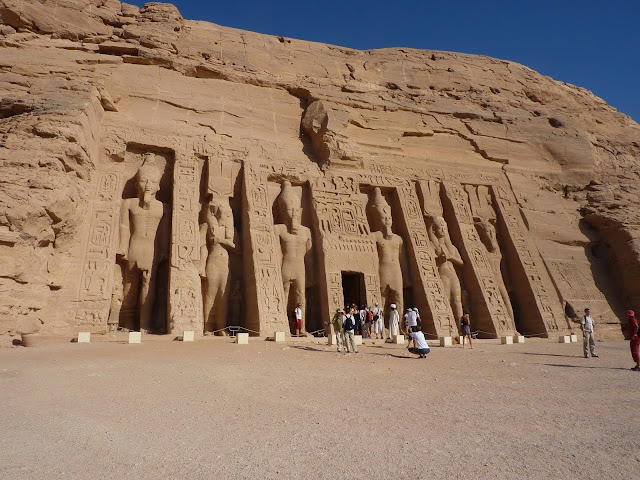
Abu Simbel
The astounding feat of the Aswan Dam is definitely another sight to see. Standing beside this incredible feature one manages once again to feel like just a tiny speck in the entire world. Architecture is everywhere in Egypt. At Philae’s Temple, on a small island, the Egyptian style temple built by a Greek ruler shares aspects of both cultures; it’s cultural diffusion at its best. The repetition of columns continues on the outskirts, yet the tops of the columns take the shape of papyrus, palm, or lotus flowers. Here, education is both visible and tangible.
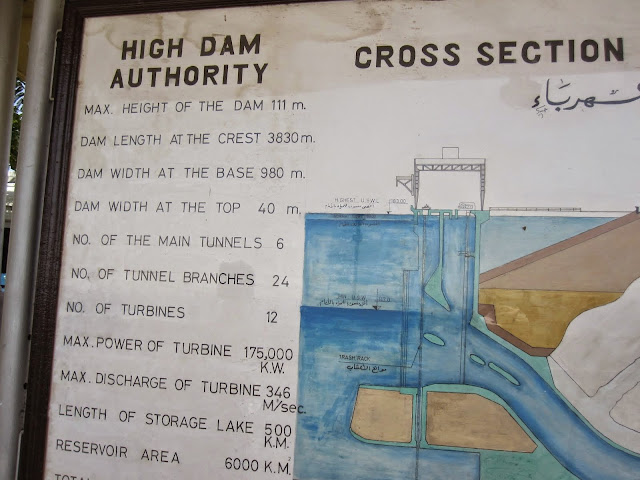
Aswan Dam
For water buffs, I highly recommend a night on a felucca. For us, we ventured from Aswan to Luxor while sailing down the Nile River. The felucca looks like a sailboat with its deck covered in mattresses and the entire area sheltered for protection from the sun. It often takes two people to guide this old school sailing vessel. No amenities are available, but a day on a felucca on the Nile promises a day that you can lie like starfish and enjoy nature’s surroundings. Our group had a support boat (a motorboat that docked beside us a few times during the day). Complete with toilets, kitchen, crew, eating area and a lounge there was not much left to chance - with my 19 mosquito bites and heavily laden bug sprayed body, I gained personal experience - I would recommend reapplying often.
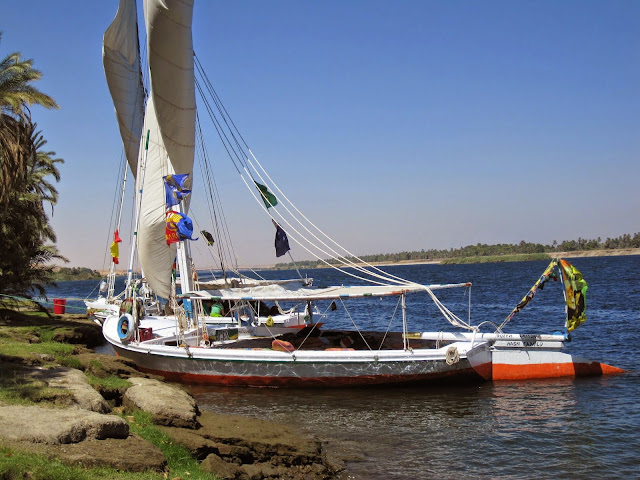
Felucca on the Nile
Another amazing experience we were gifted was a dinner in a traditional Nubian village. Looking as if you pulled this image straight out a textbook (minus the rooftop satellite dishes, of course), we relished the idea of again interacting with locals. With narrow passageways and minimal lighting, we saw houses both large and small, and with and without air conditioning lining the streets. Washing lines were draped across the pathways and brick oven stoves were visible to the naked eye. A family welcomed us into their home, serving hibiscus tea when we arrived. Known to Egyptians for the benefits of lowering blood pressure, this bright fuchsia drink tasted a cross between grape and cranberry juice. Children ran through the village as we sat at the open air table, feasting. Meat and vegetable dishes were spread across the table, followed by Turkish coffee and mint tea. There were colorful couches and bedspreads adorning this small but homey abode. The woman of the house did all of the cooking, while the man and children helped to deliver the dishes to the table. As we left, we were able to thank the hostess and her eyes responded in kind as they smiled through a burka-covered face.
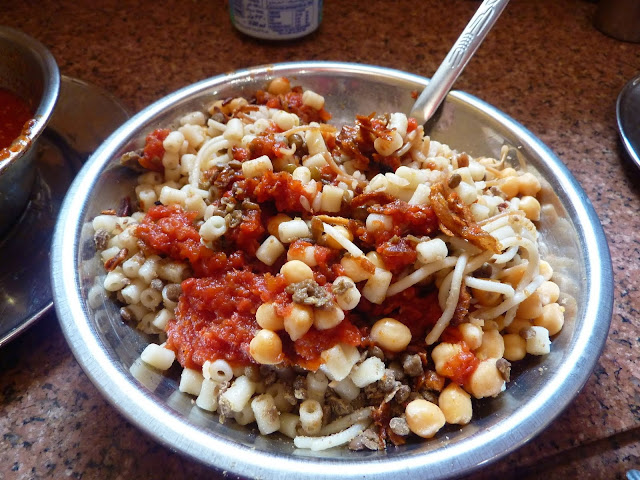
lunch in Cairo
For those who want an informal educational experience where children can learn vivid Egyptian history, the Pharaonic Village in Cairo is a good stop. An English guide leads you on a journey through Egyptian roots. The tour starts in a museum with many artifacts of Alexander the Great and his additional developments to Egypt. Then, there is a small boat (sort of like the Jungle Cruise in Disneyworld, with fewer jokes and a mechanical recording to do the taking) that takes you on a cruise through a moving museum. The slow-moving cruise shows life in Ancient Egypt with statues, animatronics, and people dressed as ancients enjoying their daily life. After the boat ride, there are many exhibits dedicated to King Tut, Anwar Sadat, and Nasser and as with any good tour, it ends in a gift shop. We witnessed how rice is made, hieroglyphics are carved, fire is started, pottery is painted, and so many other things first-hand.
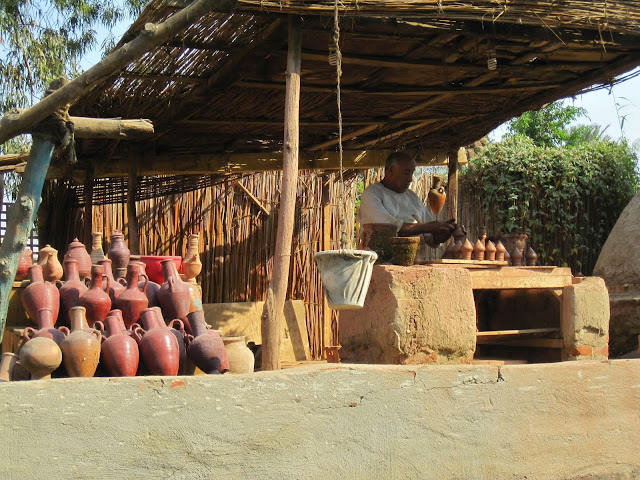
At the Pharaonic Village
Throughout Egypt, there are always sights to see. There are pretty palm trees and nature’s beauty amidst poverty and inequality. Outside of the cities, shoeless children yet to go to school can be seen riding donkeys up and down the streets, often assisting marketers to sell their wares. Fruit is often sold out of carts on the backs of horses and donkeys while dust is kicked up through the streets. Sometimes it’s difficult to witness the blatant inequality and the dichotomy of travel and tourism amidst such poverty. Egypt is a cultural paradox in every way. The old and the new traditions struggle to find a way to intertwine without losing cultural value in people and history alike. Forests of hieroglyphics that vividly share stories of the past share streets with two very specific religious ideologies and people trying to find their way in the world.
Colorful characters, religious observance, tangible history, artifacts, and the pulse of the Nile soar through this country amidst life and change. Today’s Egypt differs slightly from the one five years ago when I was lucky enough to visit, but living history and Egyptian culture continue to thrive. Although we were both hit with a bout of the pharaoh’s curse in Luxor, Mat and I are both glad to have experienced at least a part of Egypt. Few other moments have been similar to that of standing in the middle of the Sahara with a view of camels to our left and the Great Pyramids of Giza to our right. Informal education jumps off of artifacts, rivers’ edges, tombs, and plants in this ever-changing North African country of Egypt.
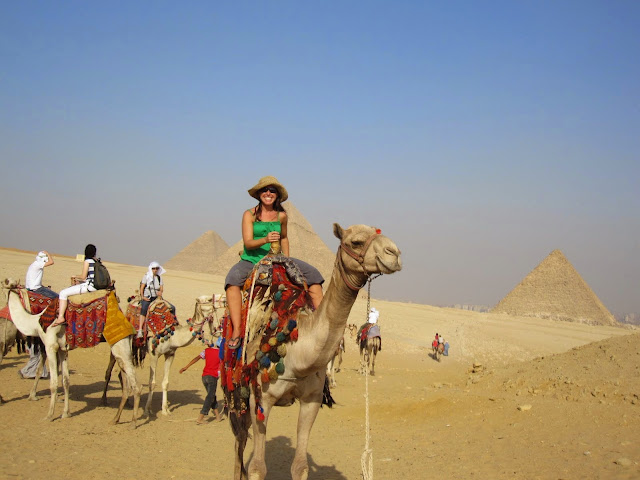
loving Egpyt!
Stacey Ebert is a traveler at heart who met her Australian-born husband while on a trip in New Zealand. Stacey was an extracurricular advisor and taught history in a Long Island public high school for over fifteen years, enjoying both the formal and informal educational practices. After a one year 'round the world honeymoon, travel and its many gifts changed her perspective. She has since left the educational world to focus on writing and travel. She is energetic and enthusiastic about long term travel, finding what makes you happy and making the leap. In her spare time she is an event planner, yogi, dark chocolate lover, and spends as much time as possible with her toes in the sand. Check out her website at thegiftoftravel.wordpress.com for more of her travel musings.
All photos courtesy and copyright Stacey Ebert
Cairo breathes learning. Egypt tells a story through the eyes of its people, the flow of its river, and the architecture of its history.
Posted by:
Stacey Ebert
